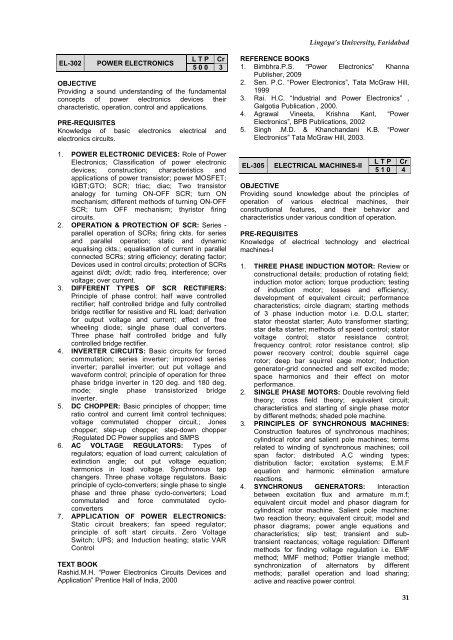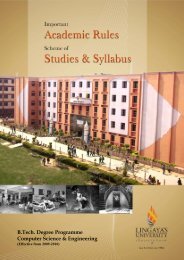Electrical and Electronics - Lingaya's University
Electrical and Electronics - Lingaya's University
Electrical and Electronics - Lingaya's University
Create successful ePaper yourself
Turn your PDF publications into a flip-book with our unique Google optimized e-Paper software.
Lingaya’s <strong>University</strong>, FaridabadEL-302POWER ELECTRONICSL T P Cr5 0 0 3OBJECTIVEProviding a sound underst<strong>and</strong>ing of the fundamentalconcepts of power electronics devices theircharacteristic, operation, control <strong>and</strong> applications.PRE-REQUISITESKnowledge of basic electronics electrical <strong>and</strong>electronics circuits.1. POWER ELECTRONIC DEVICES: Role of Power<strong>Electronics</strong>; Classification of power electronicdevices; construction; characteristics <strong>and</strong>applications of power transistor; power MOSFET;IGBT;GTO; SCR; triac; diac; Two transistoranalogy for turning ON-OFF SCR; turn ONmechanism; different methods of turning ON-OFFSCR; turn OFF mechanism; thyristor firingcircuits.2. OPERATION & PROTECTION OF SCR: Series -parallel operation of SCRs; firing ckts. for series<strong>and</strong> parallel operation; static <strong>and</strong> dynamicequalising ckts.; equalisation of current in parallelconnected SCRs; string efficiency; derating factor;Devices used in control circuits; protection of SCRsagainst di/dt; dv/dt; radio freq. interference; overvoltage; over current.3. DIFFERENT TYPES OF SCR RECTIFIERS:Principle of phase control; half wave controlledrectifier; half controlled bridge <strong>and</strong> fully controlledbridge rectifier for resistive <strong>and</strong> RL load; derivationfor output voltage <strong>and</strong> current; effect of freewheeling diode; single phase dual converters.Three phase half controlled bridge <strong>and</strong> fullycontrolled bridge rectifier.4. INVERTER CIRCUITS: Basic circuits for forcedcommutation; series inverter; improved seriesinverter; parallel inverter; out put voltage <strong>and</strong>waveform control; principle of operation for threephase bridge inverter in 120 deg. <strong>and</strong> 180 deg.mode; single phase transistorized bridgeinverter.5. DC CHOPPER: Basic principles of chopper; timeratio control <strong>and</strong> current limit control techniques;voltage commutated chopper circuit.; Joneschopper; step-up chopper; step-down chopper;Regulated DC Power supplies <strong>and</strong> SMPS6. AC VOLTAGE REGULATORS: Types ofregulators; equation of load current; calculation ofextinction angle; out put voltage equation;harmonics in load voltage. Synchronous tapchangers. Three phase voltage regulators. Basicprinciple of cyclo-converters; single phase to singlephase <strong>and</strong> three phase cyclo-converters; Loadcommutated <strong>and</strong> force commutated cycloconverters7. APPLICATION OF POWER ELECTRONICS:Static circuit breakers; fan speed regulator;principle of soft start circuits. Zero VoltageSwitch; UPS; <strong>and</strong> Induction heating; static VARControlTEXT BOOKRashid.M.H. ―Power <strong>Electronics</strong> Circuits Devices <strong>and</strong>Application‖ Prentice Hall of India, 2000REFERENCE BOOKS1. Bimbhra.P.S. ―Power <strong>Electronics</strong>‖ KhannaPublisher, 20092. Sen. P.C. ―Power <strong>Electronics</strong>‖, Tata McGraw Hill,19993. Rai. H.C. ―Industrial <strong>and</strong> Power <strong>Electronics</strong>‖ ,Galgotia Publication , 2000.4. Agrawal Vineeta, Krishna Kant, ―Power<strong>Electronics</strong>‖, BPB Publications, 20025. Singh .M.D. & Khanch<strong>and</strong>ani K.B. ―Power<strong>Electronics</strong>‖ Tata McGraw Hill, 2003.EL-305ELECTRICAL MACHINES-IIL T P Cr5 1 0 4OBJECTIVEProviding sound knowledge about the principles ofoperation of various electrical machines, theirconstructional features, <strong>and</strong> their behavior <strong>and</strong>characteristics under various condition of operation.PRE-REQUISITESKnowledge of electrical technology <strong>and</strong> electricalmachines-I1. THREE PHASE INDUCTION MOTOR: Review orconstructional details; production of rotating field;induction motor action; torque production; testingof induction motor; losses <strong>and</strong> efficiency;development of equivalent circuit; performancecharacteristics; circle diagram; starting methodsof 3 phase induction motor i.e. D.O.L starter;stator rheostat starter; Auto transformer starting;star delta starter; methods of speed control; statorvoltage control; stator resistance control;frequency control; rotor resistance control; slippower recovery control; double squirrel cagerotor; deep bar squirrel cage motor; Inductiongenerator-grid connected <strong>and</strong> self excited mode;space harmonics <strong>and</strong> their effect on motorperformance.2. SINGLE PHASE MOTORS: Double revolving fieldtheory; cross field theory; equivalent circuit;characteristics <strong>and</strong> starting of single phase motorby different methods; shaded pole machine.3. PRINCIPLES OF SYNCHRONOUS MACHINES:Construction features of synchronous machines;cylindrical rotor <strong>and</strong> salient pole machines; termsrelated to winding of synchronous machines; coilspan factor; distributed A.C winding types;distribution factor; excitation systems; E.M.Fequation <strong>and</strong> harmonic elimination armaturereactions.4. SYNCHRONUS GENERATORS: Interactionbetween excitation flux <strong>and</strong> armature m.m.f;equivalent circuit model <strong>and</strong> phasor diagram forcylindrical rotor machine. Salient pole machine:two reaction theory; equivalent circuit; model <strong>and</strong>phasor diagrams; power angle equations <strong>and</strong>characteristics; slip test; transient <strong>and</strong> subtransientreactances; voltage regulation: Differentmethods for finding voltage regulation i.e. EMFmethod; MMF method; Pottier triangle method;synchronization of alternators by differentmethods; parallel operation <strong>and</strong> load sharing;active <strong>and</strong> reactive power control.31
















